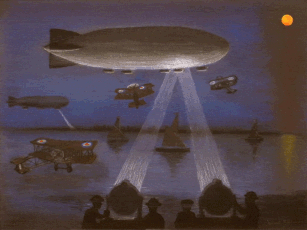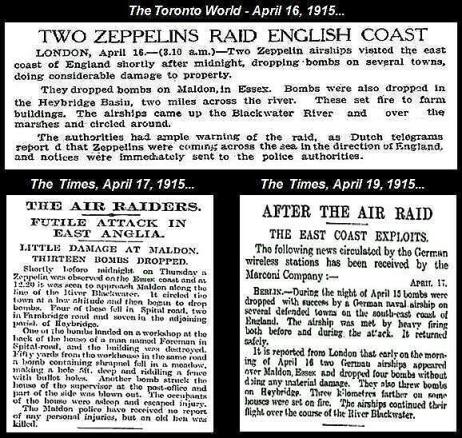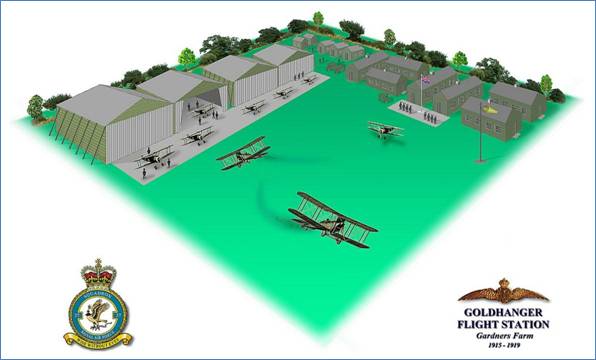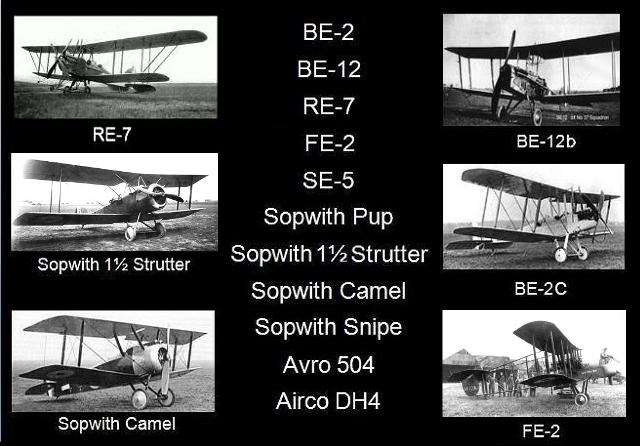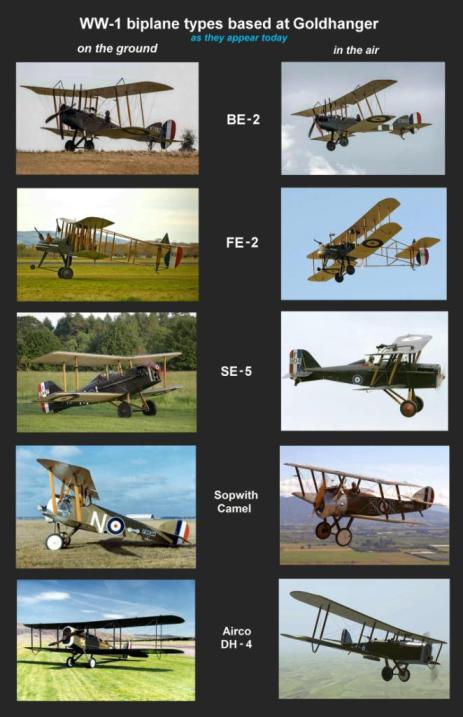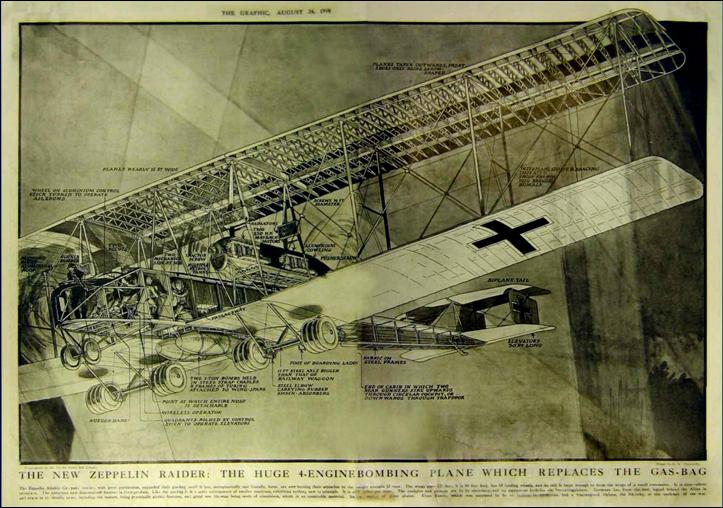The Goldhanger
Flight Station became operational in August 1915. To commemorate the one
hundred year anniversary the Goldhanger History Group unveiled a brass plaque
at Gardeners Farm shop, which today is in the middle of the former airfield and
a presentation entitled: Zeppelin
Busters over the Blackwater was given in Goldhanger Village Hall close to annual Remembrance Day
on 7th November 2015. The talk included period photos
and newspaper cuttings, early film, video and audio clips. Firstly, here is a
YouTube video that summarises that presentation...
Zeppelin Busters
over the Blackwater -YouTube video
The Flight Station was part of
the Home Defence network of the Royal
Flying Corps during the Great War and
was created to combat the new threat of Zeppelin
aerial bombardment of London. To
fully understand of the role of the station, one needs to consider the broader
picture at the time......
The
Zeppelin threat and its design features
The
first ever aerial bombardment on the UK was a Zeppelin raid on the UK was on
Kings Lynn &Yarmouth in Jan 1915. Bombs dropped from Zeppelins at home were
the new reality of war, and the country was very poorly prepared for it. Even
by the end of 1915 there was no air raid warning system in place, no shelters
and no blackout regulations. It was March 1916 before these were organised.
Between 1915 & 1917 there were 208 individual Zepplin raids on the UK,
grouped into 53 sorties, with 20 of these in Essex in the early days. In total
6000 bombs were dropped, 528 people were killed and 1100 injured, mainly
civilians.
These
were a small numbers in comparison to those killed and injured in Flanders, but
very significant in terms of the psychological impact on those at home and
particularly in the Eastern counties. Furthermore, the events of WW-2 at home,
the London blitz and the Battle of
Britain, occurring within 20 years overshadowed the impact and significance
of this first battle of britain from the 1940s onwards.
The
first Zeppelin was developed by Count Ferdinand Von Zeppelin and its maiden
flight was in 1900.
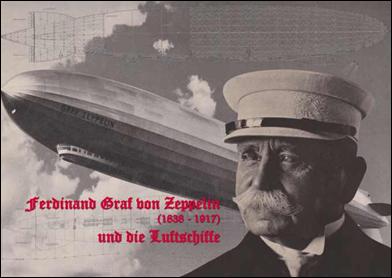
By
1914 Zeppelins had transported 37,000 people on 1,600 civilian flights without
a single incident. These pre-war Dirigibles
could fly for 1,000 miles in 30 hours without landing. The word Dirigible comes from Latin & French,
meaning: capable of being directed,
and not from the word rigid. At the
start of the Great War, Germany had 35 operational Zeppelins, each capable of
carrying a crew of 20 and a five ton load, plus fuel, provisions, and a
wireless transmitter. Their size and technological ingenuity was impressive for
the time. They were as long as 2 football pitches or 20 buses...

Each
airship required the guts of 250 000 cows - wet cut, stretched and then allowed
to dry to create the twelve internal hydrogen containers. The bovine intestines
- known as goldbeater's skins - were collected from butchers all over Germany,
Austria, Poland and occupied France, so their use in making sausages was
banned. Each Zepplin had 4 engines, and were capable of doing 50mph for
1000miles. Later models had 6 engines and could cruise at 80mph, and much
faster with the wind behind them. Their disadvantages were:
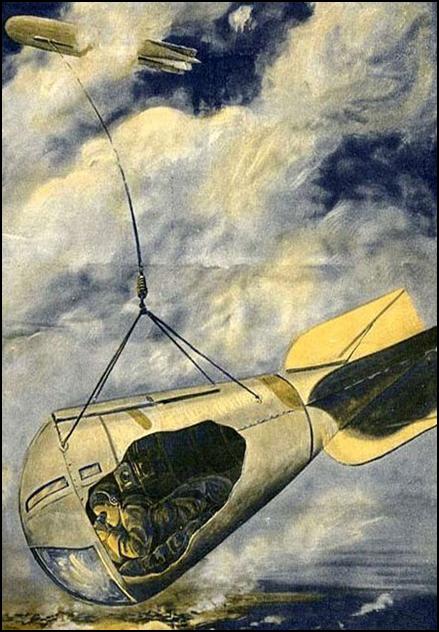 - They were filled with a highly
inflammable gas and crew had no means of escape.
- They were filled with a highly
inflammable gas and crew had no means of escape.
-
They were blown of course by strong winds.
-
They were easy targets, so they had to move at night or above clouds.
-
Their crews had no experience of navigating at night, in cloud or over the sea.
The
Spy Basket also called a Sub-cloud Car was a solution to
navigating when above cloud...
Navigation
methods
Their
primary target was London, but navigation methods initially crude and
inadequate for the task, they frequently became lost at night and in cloud.
Having reached UK land, the East Anglian estuaries were the easily visually
recognised. Methods used were...
- Ground observations - using the spy
basket
- Dead reckoning - last position +
direction & distance
- Traditional shipping methods:
magnetic compass, sextant, the stars, the sun
- Later they used Direction Finding
radio equipment, using transmitters in Germany
The
Propaganda War
One
of the objectives of Zeppelin bombing raids was to terrify the UK civilian
population at home, so an intensive propaganda campaign using posters and
postcards was undertaken by the Germans at the time. Here are some samples...
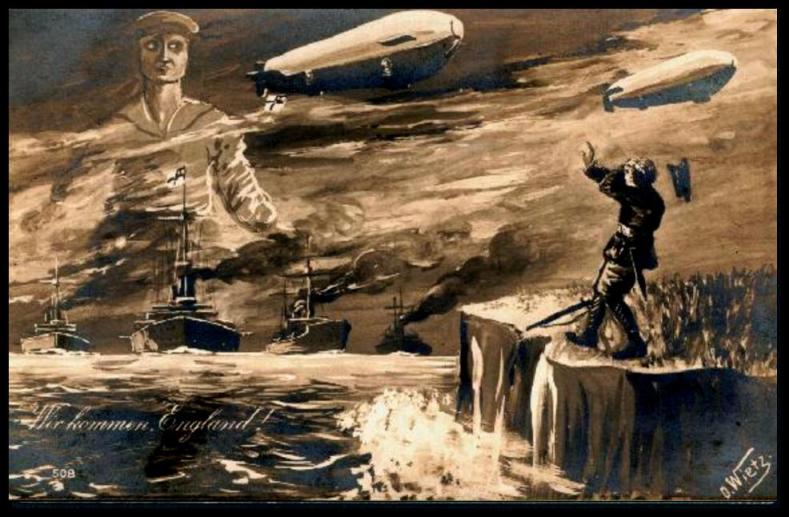
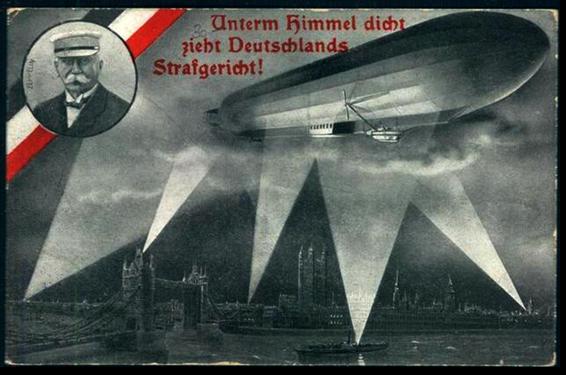
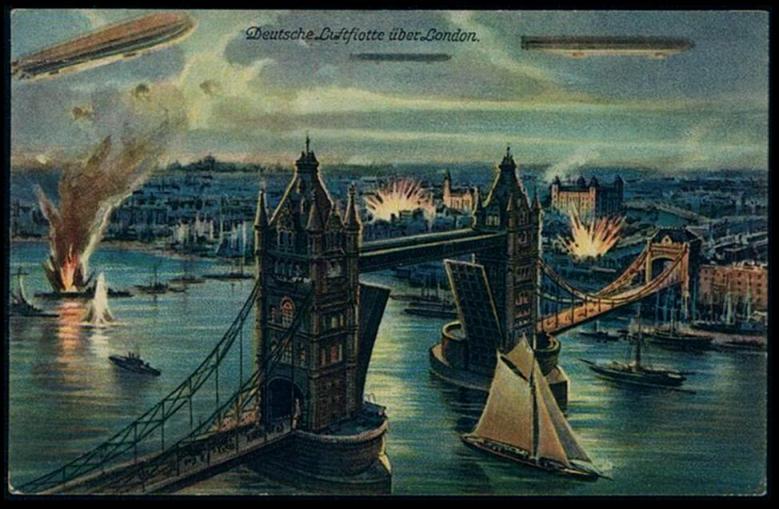
This
British cartoon is an indication of the effect of the propaganda...

Zeppelin
routes
This
Illustrated London News map published
at the time shows distances & times from the two main Zeppelin bases, and
shows the routes to London going over Essex...
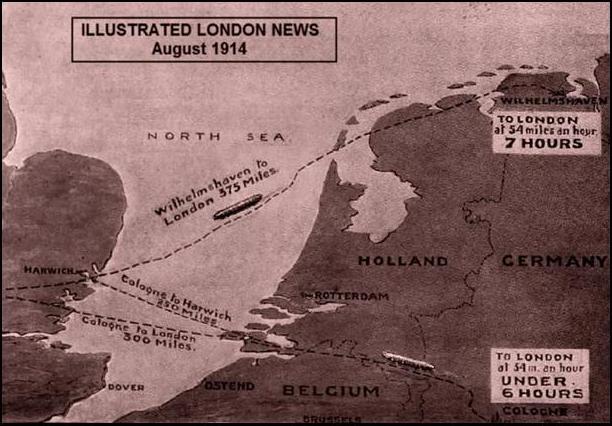
It
is said that the Zeppelins could identify the Blackwater Estuary, then fly up
the Chelmer river to Chelmsford and then followed the railway line to London.
Probably due to navigation errors the initial targets were in East Anglia along
the coast, but they progressed towards London, as shown on this map...
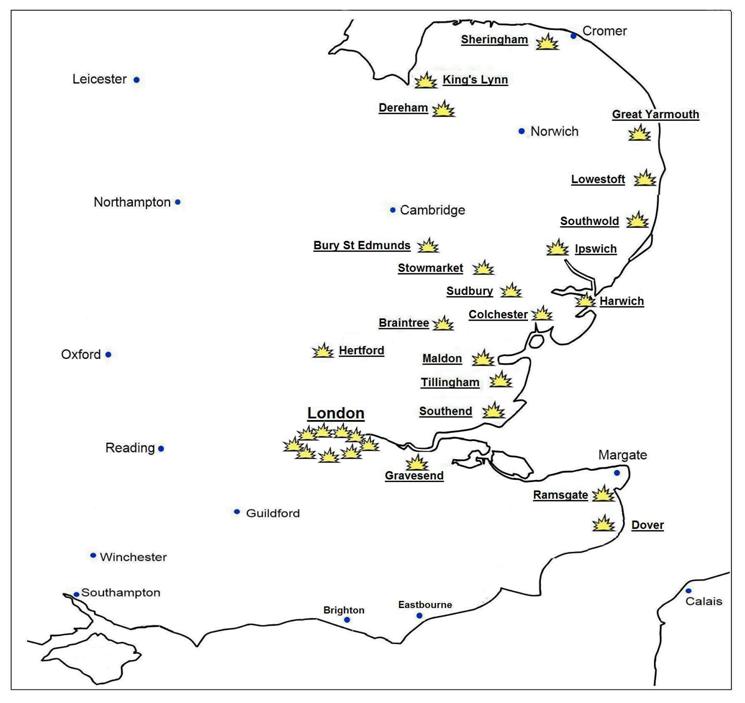
Extracts
from Dr Salter`s diary
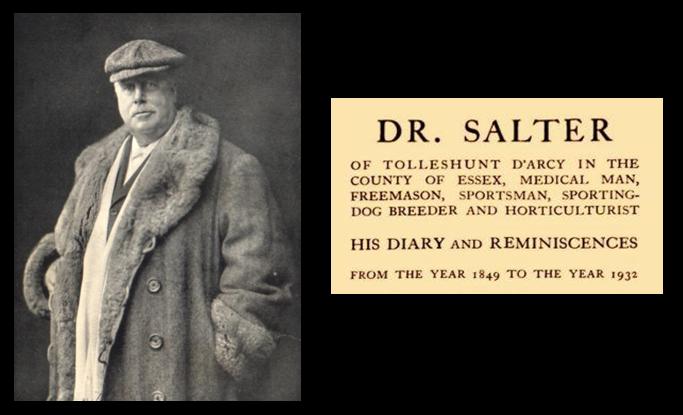
For most of his
life Dr Henry Salter, who lived in Darcy, maintained
an extensive daily diary, and continued to do so during the Great War. He made
52 references to air-raids, of which 34 specifically mentioned Zeppelins.
Others referred to raids and many of
those were the later Gotha and Giant bombers. 23 raids he personally witnessed,
and as Chief of the Essex Special Constabulary, and a Major in the Essex
Volunteer Force, he had very good sources of information. Here are some of the
extracts from the diary that refer to the raids...
April 1915 A Zeppelin raid on Maldon,
also a raid in Kent. They come over too often!
May 1915 News of a Zeppelin at Southend and a fire in the town.
This war is awful.
May 1915 A Zeppelin discharged 70 or 8o bombs over Southend last
night and another threw some down at Burnham
and Latchingdon.
Jan 1916 Three airships over - one came to grief at Wigboro'.
Jan 1916 I was operating at Kelvedon
for three hours, and in the midst of it all was a Zeppelin raid, trains
stopped, lights out, a fire on the horizon in direction of Maldon, of some
magnitude, probably Southend. Had to come home slowly.
April 1916 Eleven Zeppelins in last night's raid. One, clearly
seen, came right over my house, and went on to Braintree and Sudbury.
Sept 1916 Going to bed at 10.30, at 12.30 the servants told me
that Zeppelins were about. ... It was some distance off, and was ultimately
found to be at Billericay Common.
...a second Zeppelin was a mass of flames within a few minutes of the other!
... shortly afterwards found to be at Little Wigboro'.
Oct 1916 Searchlights enliven the night from many quarters
keeping us in mind of the war and reminding us that someone is looking after
our safety (perhaps!).
July 1917 The air full of the strange noise of aircraft warning us
for an air raid. Collecting on the lawn, the men, servants, and myself, soon
saw the enemy like a flight of rooks in the air speeding to London. I counted 23 of them, some saw 26. They
went the usual course, over Bradwell, then up
the Blackwater, to London. After an hour, they came back over the same
course. We counted the same number, not one had been stopped. Thirty-seven
people killed and 141 injured not so much as I expected.
Aug I917 While we volunteers drilled in the meadow, nine German
aeroplanes went over high towards London. They seemed to alter their minds
after going a little distance, and made a hasty retreat homewards. I should not
think from the absence of noise, that much damage was done. The Goldhanger airships [sic] went after
them.
Sept 1917 Another raid. They came right over the house. This makes
a raid every night this week. They were high up, invisible, and proceeded
towards London. Soon we heard of their arrival there by long and intense
cannonading, rockets, and all the usual implements of air-warfare.
Nov 1918 I went by the 10.34 fast train to London. News of Peace
was in the air, so that the day began with excitement, and by night nearly
everything was disorganised and chaos - especially London, which was a
pandemonium! At 11 o'clock Peace began, and also the orgies attendant thereon.
The East Anglian targets
A
large number of the East Anglian towns were bombed by Zeppelins. Kings Linn was
the first raided on 19 Jan 1914. Here are the bomb damage scenes from
Colchester, Braintree and Southend...
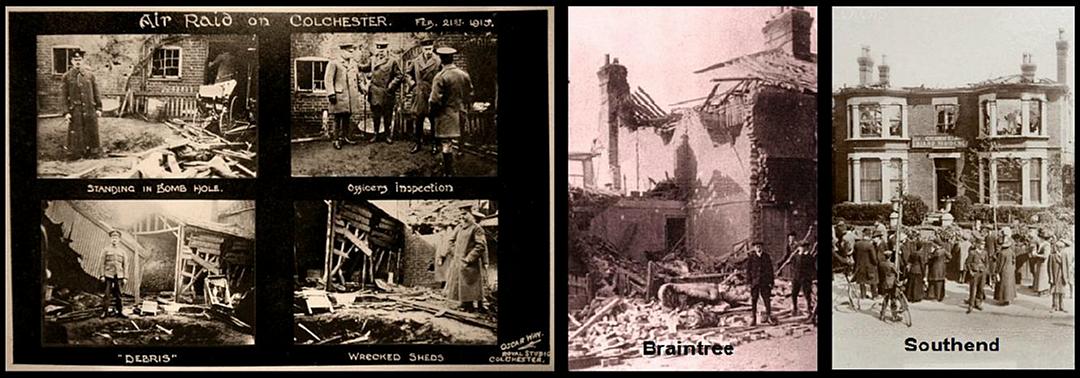
Maldon
was bombed on 16th Apr 1915, and the cottage opposite St Peters Hospital in
Spital Rd. was badly damaged...
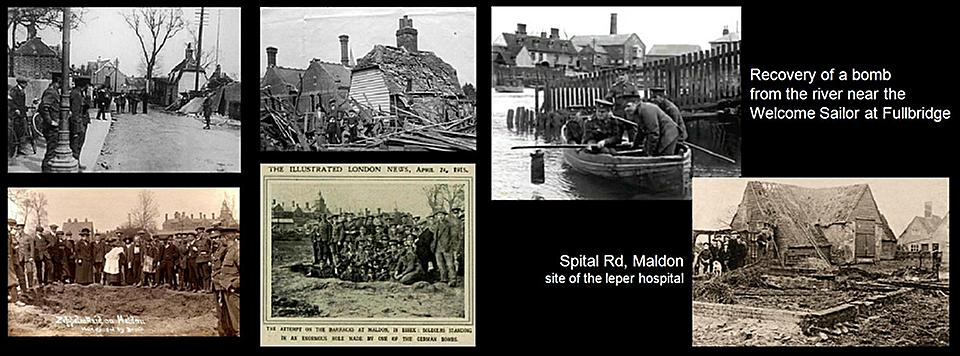
A
Zeppelin bomb was recovered from the river opposite the Welcome Sailor at
Fullbridge, and the damage to an ancient barn in Spital Rd, Maldon exposed the
remains a leper hospital. The same Zeppelin had earlier attacked Heybridge
Basin and Heybridge Hall where all the windows were blown out, and it later
attacked Tillingham but no damage was done. The Goldhanger Parish Magazine
referred to this raid:
Many here were thoroughly scared,
and no doubt rightly so by the air raid and bomb throwing
at Maldon and Heybridge, and all
are agreed we had a merciful and God-sent deliverance.
In his memoirs the commander of the
Zeppelin revealed they had no idea where they were when they bombed Maldon!
Many
newspaper articles referred to the Maldon raid and it was reported in Toronto
even before The Times in the UK, because censorship delayed reporting for a
several days...
Here is a summary of casualty figures.
In 1915-1916 most were from Zeppelins and were the first losses of civilians at
home...
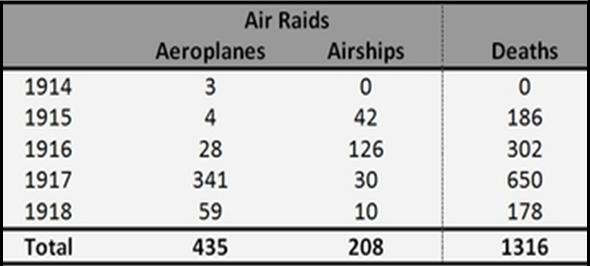
The UK response
The
initial UK propaganda was a recruitment drive, because ironically the Germans
terror campaign only served to stiffened the British resolve and dramatically
improved recruitment in rural areas in East Anglia...
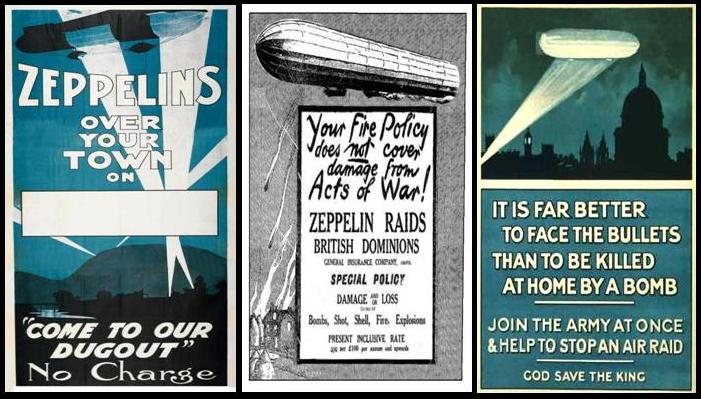
Initially
the UK had little defence. Early experimental sea planes designed to attack
Zeppelins at sea, tested in the Blackwater and based on Osea Island failed. The Island became HMS Osea and was used for torpedo chasing Coastal
Motor boats (CMBs) throughout the war. The
picture on the left shows Rivermere house on Osea in the background...

At
the start of war anti-aircraft guns had not been developed, as those military
aircraft that existed were seen as reconnaissance only rather than offensive
threats. When Zeppelins and aircraft started to be a threat, field guns were
improvised to point upwards...
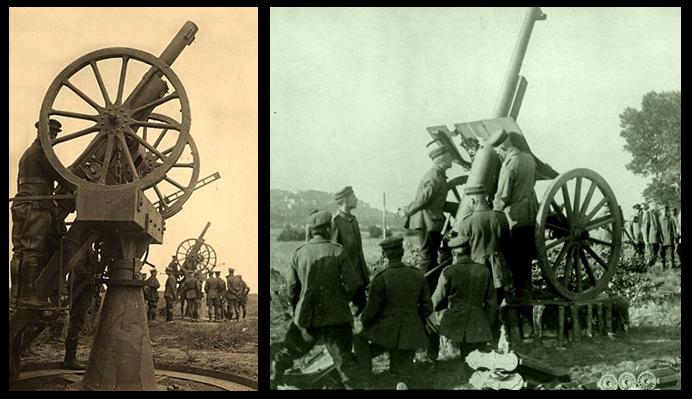
Recruitment
Government
posters from the time show attempts to recruit mechanics and carpenters. The
lowest rate of pay in the RFC was twice that of the infantry: 2 shillings, and
RFC ground crews were considered to be a safe option. They needed to recruit
because although the RFC had been formed in 1912, most of its aeroplanes and crews
were already in France...
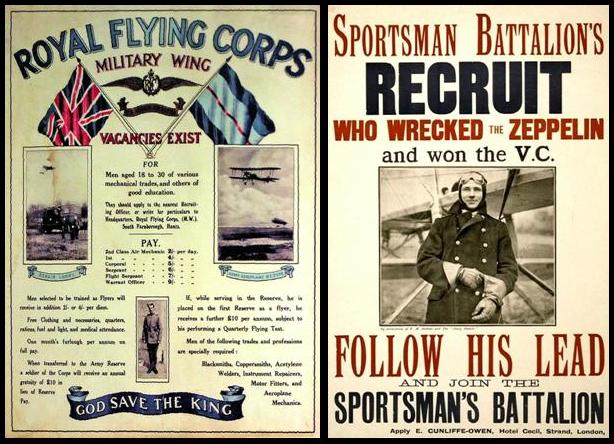
The local airfields
This
map shows the locations of the RFC flight Stations clustered to the east of
London and near the coast...
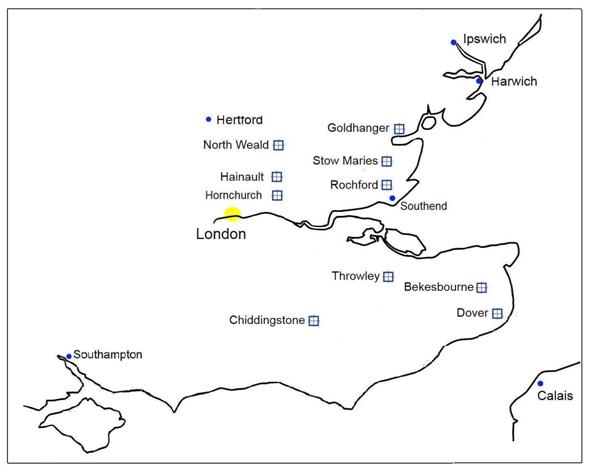
37 Squadron was based at three sites:
Goldhanger - A Flight, Stow
Maries - B Flight, Rochford - C Flight
39 Squadron was based at: North Weald
Bassett, Suttons Farm, Hainault Farm
The left map shows the location of the
Goldhanger site wrt the village and the right map shows the layout of
buildings...
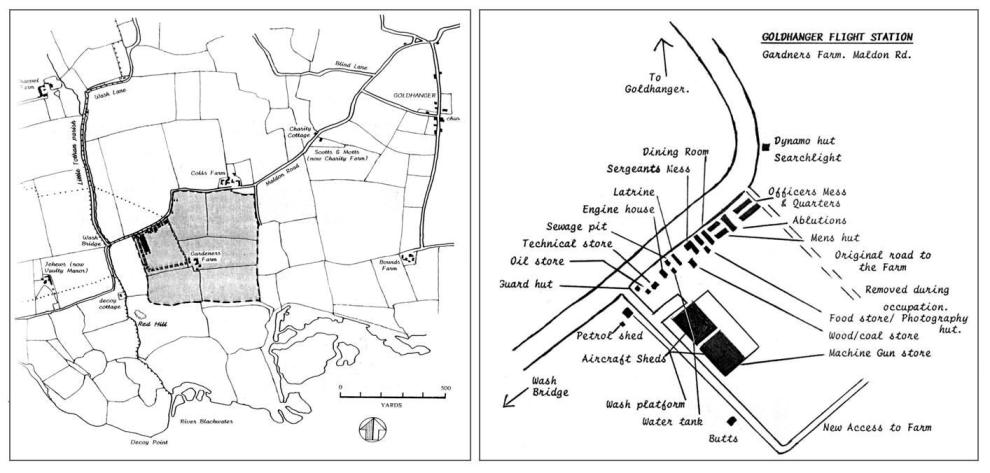
more period photos of the Flight
Station are available at... Great War - Flight
Station
and from the maps and the photos we
can reconstruct what it looked like from the air...
There
were no hard runways, just grass fields and one problem for the pilots was finding
their way back to their bases in the dark. Here is an extract from: The War in
the Air by H Jones, published in 1922...
Until 1916 flares were used on
night-landing grounds which were cans filled with petrol and waste. There was
no standard distance between flares nor was the number of flares to be used
defined. Each aeroplane was fitted with two parachute flares to facilitate a
forced landing.
In 1916 a standard method of placing a
new type of flare came into use. This was made of asbestos packed into a wire
cage, and soaked in a bucket of paraffin. It was simple, and required little
attention, and its light penetrated mist and fog with some success. In
addition, small oxy-acetylene searchlights were used to illuminate
the flare path while aeroplanes were landing. Up until to the end of 1916
volunteers were in charge of this lighting, but in 1917 this was taken over by
the Royal Defence Corps.
In
contrast to Goldhanger, imagination is not needed to know what Stow Maries was
like, as most of the buildings have survived and it is the ideal situation for
restoration, and a living museum...
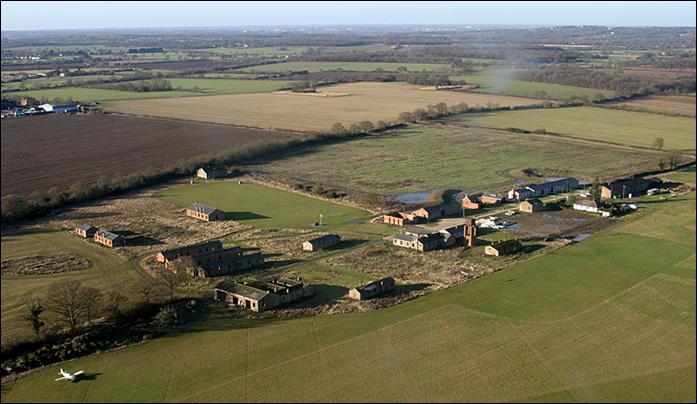
However,
the nearest we get to what Rochford Flight Station was like at the time is the
watercolour painting by Dave Daggers (below left) that indicates that he at
least believed that there were even less buildings there originally than there
were at Goldhanger. In WW-2 the site became an RAF station, and now it is the
ever expanding Southend Airport...
Aircraft based at Goldhanger
|
From log
books we know At least 11 different types of aircraft were based at Goldhanger
at different times, although there were thought to be never more than 8
aircraft based there at any one time. By comparison with Zeppelins these
bi-plans were remarkable small fragile machines. They struggled to reach the
altitude of the Zeppelins, and pilots had to cope with both sub-zero
temperatures and a lack of oxygen. The aircraft had open cockpits, no radios,
no brakes, no flaps and no parachutes! Most had 80 horse-power engines with
fuel for only 2 hours flying time. To overcome the problem of short flying time,
a series of Landing Fields with
minimal facilities were created: mowed grass strips, landing flares, a fuel
tank and a shed with a telephone. Select
this image to enlage... |
||
|
The FE-2 was designed at the Farnborough
Aircraft Factory and 'FE' stood for 'Fighting or Farman Experiential', but despite the name they had a
major role as Zeppelin chasers during the war. Over a 1000 were built and 200
were used for Home Defence. Similarly, the 'BE' in 'BE-2' stood for ' Bleriot Experiential', a de Havilland designed
machine, of which over 3,500 were built by 20 manufacturers. There is
a 1-minute silent film of an FE-2 being moved out of ' sheds' which are remarkably like those
once at Goldhanger (but it probably wasn't filmed at Goldhanger), which can be
seen at... Youtube.com
- Royal Aircraft Factory FE2 Today,
with many restorations and reproductions of these WW-1 biplanes we can now
see high definition close-ups of them in full colour, both on the ground and
in the air, which was not possible in the early 1900s due to the limitations
of photographic technology at that time. Select
this image to view the high definition photos and zoom in... |
||
Finding the enemy
Zeppelin
raids were mostly at night and they were frequently stayed well above the
clouds. Radar wasn't
developed until WW-2, so the sound of the two engines was the main means of
identifying the Zeppelin's
position and direction. In the early years of the war, blind persons with acute
sense of hearing were employed as ground observers to detect the incoming
airships.
Once
RFC pilots had taken off, they would not have heard anything other than their own
engines, and with the enemy above the clouds, in the dark, and with no radio,
the pilots needed to know which direction to head before they took off.
By the time the War Office had been informed and the crews had been scrambled,
and were airborne, probably 1/2 an hour would have passed, so it was also
import to know the direction the Zeppelin was travelling in as well as its
position. To meet this need, large concrete Sound
Collectors were developed as an effective method of amplifying and determining
the direction of the sound. 200 concrete Sound
Collectors were built along the East Coast...

The
sound of the approaching Zeppelin was reflected off the surface and into a
trumpet mounted on a column. The trumpet was connected to a stero stethoscope
used by the operator. The angle of the pole indicated the direction of the
approaching aircraft. A later design (on the right) was a mobile unit with four
trumpets that rotated to identify the location of the incoming sound both
laterally and vertically. The Goldhanger Flight Station had two searchlights
which were also very important for identifying Zeppelin positions once they
were closer to land...
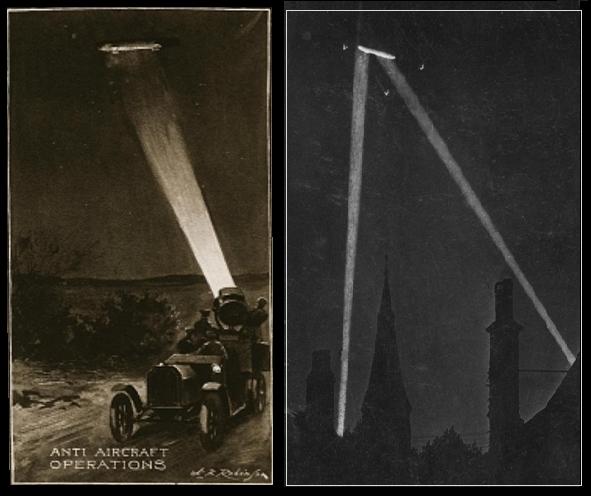
Two
searchlights were very important to enable triangulation
of position and height. If one knows the distance between the lights and the
angles that they are pointing, one can chart, or calculate the position and
height of the target. The searchlights were also used to show the crews the way
back to their base.
Marconi
in Chelmsford played an important role in both WW1 and WW2 developing radio Direction Finding Radio equipment. Zeppelin L48
in shown on this 1980s BT phone card, was one of the Zeppelins shot down
locally...
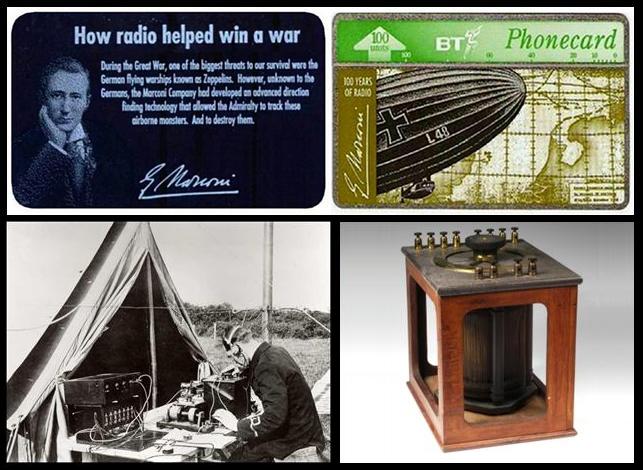
RFC Aircraft Weapons
Weapons carried on the aircraft were minimal. Initially
the pilots were supplied with incendiary darts or bomblets to drop over the side on to the top of the Zeppelins.
However the Zeppelins were often at a greater height than the RFC biplanes
could reach. Furthermore, if the darts did not hit the target or ignite, they
fell to the ground and started a fire!

The
earlier biplanes were single seated and had a Lewis machine gun that the pilot
had to operate himself. To avoid shooting the propeller and so the flash of the
gun did not temporarily blind the pilot, the gun was mounted over the upper
wing which the pilot operated with cables.
Machine
gun fire from below the Zeppelin, was initially completely ineffective, as the
bullets went straight through the gas bags and the holes either re-sealed
themselves or were sealed by Riggers
working within the Zeppelin! However, special incendiary bullets were later
developed. These also initially failed to ignite the highly inflammable
hydrogen and it was only when the pilots discovered that discharging a complete
drum of these bullets in one concentrated spot did they finally manage to also
get some oxygen inside the bag and set the hydrogen alight. Some of the later
machines developed, such as the FE-2, had two seats and two machine guns.
Zeppelins brought down
by Essex pilots
Five
Zeppelins were brought down by Essex pilots. These pilots from 37 Squadron
based at Goldhanger and 39 Squadron based at Hornchurch frequently moved
between Squadrons and the Essex airfields, so although some of those identified
below did not take off from Goldhanger on their notable Zeppelin destroying
missions, they are included here for completeness.
Information
from Goldhanger Flight Station operational logs of the time, kindly supplied by
Charles Marshall, gives us a fascinating insight into the way in which the
station participated with other aerodromes in major raids on London and the
South East. The logs analysed give details some 32 operations from Goldhanger.
The large numbers of Zeppelins and Gotha bombers involved, and RFC biplanes
responding seems now remarkable. The logs also tell us that pilots based at
Goldhanger participated in sorties as far afield as: Dover, Folkestone,
Chatham, Sheerness, London, Romford, Harwich, and Felixstowe. This is
particularly amazing as the flying time for their machines was only two hours.
The incidents are presented in chronological order...
2-3rd Sepember 1916 - Lt. William Leefe-Robinson of 39-Squadron
shot down SL11

On
the night of 2-3rd September 1916, Lt. William Leefe-Robinson took off
from Suttons Farm near Hornchurch in a BE2-C with the new incendiary
ammunition. He needed to fly very close to the Zeppelin order to fire the
ammunition from his special Lewis gun to set the airship alight. He was the
first pilot to successfully achieve this and the Zeppelin came down in Cuffley,
Herts. SL11 was the first airship brought down in this way, and the crew of 16
were all killed.
As
the airship was made of plywood rather than aluminium, the photos of the
wreckage show no mangled metal. The wooden structure burned even more furiously
than the Zeppelins constructed with aluminium. Robinson was awarded the Vitoria
Cross and his actions had a huge effect on public morale. Bringing down SL11
was also seen as a military triumph as at the time and it was also attributed
to successful Radio Direction Finding and the interception of coded messages to
give routes and targets.
23 Sep 1916 - L33 was destroyed by anti-aircraft fire and
crashed at Lt. Wigborough
Three
weeks later on the 23 Sep 1916, there was a massive air attack by eleven
airships, including three of the newer Super
Zeppelins. The lower part of the Zeppelins had been painted black for
camouflage against searchlight beams. After discharging their bombs and on the
way back, L33 was attacked over Chelmsford by anti-aircraft guns and a squadron
of fighter planes from Hainault. The airship did not catch fire, but after
several hits that would have holed the gas bags, the Zepplin began to lose
height and jettisoned its machine guns over the Wilkin & Son factory at
Tiptree in an attempt to regain height. This did not succeed and the Zepplin
came down at Little Wigborough...

At
Great Wigborough at about the same time a baby daughter was born to a Mr and
Mrs Clark, and at the suggestion of Dr Salter, who was attending the delivery,
the baby was christened Zeppelina and he described the incident in detail in
his diary. He also made other references to this crash in his diary. The
Zeppelin landed more or less complete and the equipment was seized to provide
the Ministry of War with vital design information. 250,000 visitors paid 2d for
a glimpse of the scene over the following months and small items were sold to
the spectators as souvenirs.
23rd September 1916 - 2nd Lt. Frederick Sowrey shot down L32 at
Billericay
On
the same night as the Little Wigborough incident Second Lieutenant Frederick
Sowrey, of 37 Squadron, who had taken off from Hornchurch, shot down L32 and it
crashed at Great Burstead, near Billericay. All of the crew of L32 were killed.
The action was picked out in the beams of search-lights and was watched by
thousands of people, who turned out on the following days to gaze at the scene
and acquire souvenirs sold at 6d each. Pieces still appear on Ebay. Sowrey was
awarded a DSO and was later promoted Captain and Commanding Officer of
Goldhanger Flight Station. He was also later awarded the Military Cross and his
final tally in WW-1 was twelve enemy airplanes destroyed.

1st October 1916 - W J Tempest shot down L31 at Potters Bar
2nd
Lt. Wulstan Tempest of 39 Squadron based at Suttons Farm near Hornchurch shot
down L31 on 1st October 1916. The spectacle of the Zeppelin on fire was
dramatically caught in searchlight beams and many people saw it from miles
around. Hence tens of thousands of people were attracted to the crash site in
the following days. L31 was part of massive of eleven Zeppelin attack
attempting to reach London. Only L31 made it to central London.

2nd
Lt.Tempest's petrol pump
failed while attacking L31, and he had to use a hand petrol pump while he
attacked the Zeppelin. After successfully setting the Zeppelin alight, Tempest
himself crash landed at North Weald and fractured his skull. He was awarded the
Distinguished Service Order. The Zeppelin
Oak (shown in the photo) became a monument until it was cut down in the
1930s.
The Three Heroes of the day
Leefe-Robinson,
Sowrey and Tempest were unquestionably heroes at the time and many award
ceremonies, newspaper articles, and postcards followed, including much
publicity abroad. Censorship prevented identifying the village involved, as in
these images....

23-24th May 1917 - a six Zeppelin night raid on London
This
is the earliest extract available from the Goldhanger log. It was a six
Zeppelin night raid on London. Five planes from Goldhanger were involved out of
as total of 76 RFC planes on the night! Both Brothers Captain Frederick Sowrey,
Captain William Sowrey and L P Watkins participated. They attempted to
intercept L42 but failed. Frederick Sowrey managed to use three different
planes on that night and William Sowrey used two, crashing one on landing. His
second sortie in another aircraft was cut short when a sooted spark plugs
forced him down at the Easthorpe Night Landing Ground.
One person was killed and several were injured during the raid.
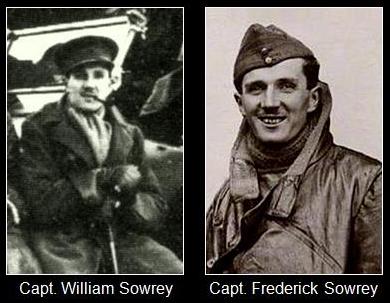
Dr Salter referred to this raid in his
diary:
24 May 1917 - Zeppelins over, and
aeroplanes everywhere, with searchlights. Everything lively, but not much
damage.
25th May 1917 - the first Gotha raid in daylight
Twenty
three Gotha bombers attacked Folkestone and civilians were 95 killed. 77 RFC
planes participated with 4 from Goldhanger. The number of planes involved from
both sides in these initial Gotha raids was amazing. Overall one hundred Gothas
were built, and sixty were lost on UK raids. The Gotha had replaced the
Zepplins, and pictures do not convey either the size or capability compared
with the much smaller RFC biplanes. Gothas had a crew of three, two engines,
one front and two rear facing machine guns and a substantial bomb carrying
capacity: fourteen 60 lb bombs.

13th June 1917 - a daylight raid on London by twenty Gotha
bombers
94
RFC planes were involved with 4 participating from Goldhanger. The Gothas were
too high to be reached by the RFC planes. 162 civillians were killed and 400
were injured around the
Liverpool Street area of London.
17th Jun
1917 - L48 shot down near Theberton, by Lt. L P Watkins
On
the 17th Jun 1917 there was a four Zepplins on a night raid of London . Four
planes participated from Goldhanger to make a total of 32 RFC aircraft. The
Goldhanger pilots were Capt. W. Sowery, Lt. L.P. Watkins (from Canada) Capt.
C.A.Ridley, and Lt. G.Keddie. Lt. Watkins, in a BE-12, attacked L48 over
Orfordness while it was on its first operational flight and just 3 weeks after
the maiden flight. Pierce Watkins discharged 3 drums of incendiary bullets (3
times 92 rounds of ammunition), it caught fire and crashed in between Theberton
and Leiston in Suffolk. Three crew members survived, but fourteen others were
killed and were initially buried in Theberton Church. This was the last
Zeppelin to be shot down. Lt. Watkins was awarded the Military Cross.


A
cyclists battalion of the Suffolk Regiment threw a cordon around the wreckage,
but despite all their efforts to keep people away, countless bits and pieces
were taken and are still shown as souvenirs in Suffolk homes. An estimated
30,000 people visited the crash site. L48 was the last of the five Zeppelins to
be shot down on UK soil. There is a small display of Zeppelin parts in the
entrance to Theberton church.
19-20th
October 1917 - Eleven new V class Zeppelins attack on the UK at night
Four
pilots from Goldhanger participated: Lt. P.R.Cawdell, 2nd Lt. S.Hay, 2nd Lt. S.
Armstrong and 2nd Lt. C.L.Milburn, with a total of 78 other RFC planes involved
on the night. The log recorded 'Various
inconclusive interceptions took place'.
This was a new class of Zepplin which operated at a greater height which was
too high for searchlights or anti aircraft guns, so defence was left to
defending aircraft. It became known as the silent
raid. Various inconclusive interceptions took place but no Zeppelins were
destroyed. It was the last major Zeppelin raid on the UK. 36 civilians were
killed.

29-30th
January 1918 - a four Giant bomber raid on London
Due
to the successes of 37 & 39 Squadrons the Zeppelin threat had receded by
the end of 1917 and the German Army disbanded its airship divisions but the
strategy of long range bombing continued using Gotha and Giant bombers. On
the 29th January 1918 a Giant bomber was seen over the Blackwater at 22.15hrs
at 12,000ft by Capt. Arthur Dennis during a routine night patrol. He intercepted
the Giant and put several bullet holes into it emptying two drums of
ammunition. The Giant put several bullet holes in Dennis's aircraft. Captain
Arthur Dennis of No37 Squadron at Goldhanger made an emergency landing in the
field beside the Canal at Heybridge Basin. The Giant went on to drop its bombs
over Richmond, Kew, and
Chiswick. 10 people were killed.
Capt. Dennisís BE-12 in a Heybridge
field
a diagram of The Giant in The Graphic in August 1918
The
Giant had a crew of 7, a commander, 2 pilots, 2 mechanics, 2 rear gunners, 4
engines, 18 wheels, 4000lbs of bombs, Thirteen were built during the war, and
they were used on thirty sorties over the UK which involving a 7 hour round
trip. None were lost over the UK.
a set of operational records for 32 sorties of 37
Squadron at Goldhanger between 1917 & 1918 are here...
†Operational
Records† †††(13-page PDF file)
Four
pilots from No.37 squadron based at Goldhanger lost their lives in the later
part the war. Their story is told in...
Great
War - Goldhanger Flight Station losses
On-line video clips
These
on-line video clips convey the scale and atmosphere of the events...
"Zeppelin
Busters over the Blackwater" - a locally produced introductory video - 9
minutes long...
https://www.youtube.com/watch?v=3M50R2ZZdCc
BBC Timewatch - The
Mount of Aces - has snippets of real WW-1 FE2s - 5 minutes long...
http://www.bbc.co.uk/timewatch/acesfalling2.shtml
East Anglian Film
Archive - 1972 BBC film - Zeppelin raids over East Anglia - 30 minutes,
And includes
Leiston (16 mins in) and Lt Wigbourgh (18 mins in)...
http://www.eafa.org.uk/catalogue/39
Zeppelin Over Essex
1914-1918 - shows Spital Rd, Maldon and the river - 30 seconds
http://www.britishpathe.com/video/zeppelin-over-essex
Royal Aircraft
Factory FE2 leaving a WW-1 hangar - no sound- 1 minute
https://www.youtube.com/watch?v=an5xl0IylYI
World War One -
Terror in the Skies - 11 minutes
https://www.youtube.com/watch?v=e6-BZ2MzKMI
span>
BBC 2014 video -
Little Wigborough, Essex: Zeppelin Crash - 2 minutes
http://www.bbc.co.uk/programmes/p01s6xxs
.
. . and
finally, The Maldon Brewing Co. also commemorated the 100th
anniversary of these events...

top Great War - Flight Station
Night Landing Grounds Flight Station losses
home
